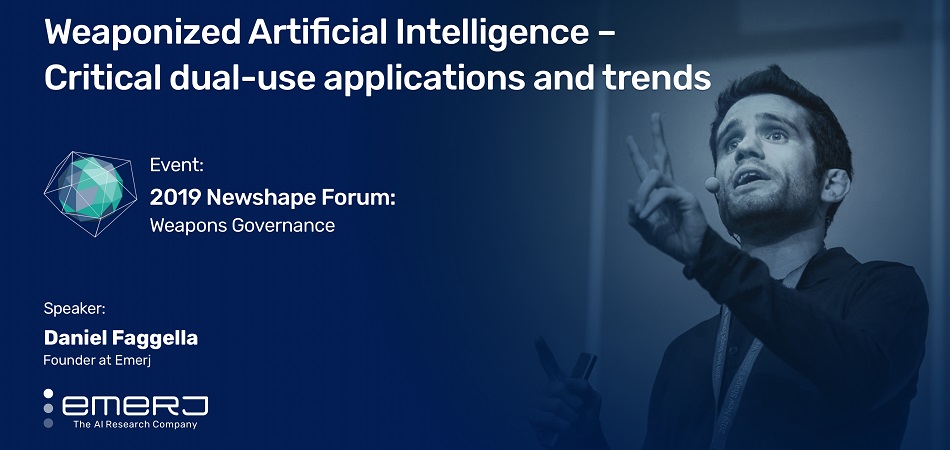This article is based on a presentation given by Emerj CEO Daniel Faggella in Geneva, at the 2019 New Shape Forum: Weapons Governance for the Geneva Disarmament Platform. To learn more about Emerj’s AI presentations and speaking, visit our presentations page.
There are many more AI applications than there are governments and militaries experimenting with AI. But the AI products that are becoming more commonplace in the business world do have their use in national security and defense efforts.
It will take years to update physical weapons systems, such as tanks, planes, and missiles, with machine learning technology, but there are ways to weaponize artificial intelligence without mounting it on any weapons. The fast-moving world of enterprise AI will be the origin of various dual-use applications that can be repurposed for military use-cases.
At Emerj, the AI Research Company, we map the capabilities of AI across security, surveillance, and defense – including dual-use AI applications. In our work with government and enterprise clients, and in presentations for organizations like United Nations and INTERPOL, we emphasize the importance of staying abreast of general AI capabilities that have significant future impacts on security and risk. From computer vision applications in retail to text summarization technology in the legal field – AI’s capabilities are being used as both weapons and defenses.
In this article, we break down the dual-use applications of three prominent AI techniques, all of which will be important for weaponizing AI in the future:
- Computer Vision: Image and video analysis to survey physical space and respond to behavioral patterns
- Natural Language Processing: Text and voice analysis for real-time translation, summarization, sentiment analysis, and information extraction.
- Programmatically Generated Content: AI-generated 3D representations of people, places, and things.
The slide deck for the original presentation is embedded below:
Application 1: Computer Vision
Computer vision is the AI capability to analyze visual information and use it to detect changes in real-time. Computer vision capabilities include pattern detection and image analysis.
Retail: Pattern Recognition
Brick-and-mortar retail stores use computer vision-enabled security systems for pattern recognition, allowing them to detect shoplifting and other kinds of theft, including instances in which cashiers intentionally fail to scan an item when ringing up a customer. Computer vision applications can alert security teams when it detects a customer putting an item into their bag or coat, for example, allowing them to respond before the customer has left the building.
Computer-vision enabled pattern recognition software can be repurposed for surveillance efforts. Governments and militaries could integrate computer vision software into security cameras along building perimeters or on vehicles in order to track the movements of suspicious people and enemy personnel.
Finance: Image Analysis
Computer vision software can be trained to detect entities within an image or real-time video. Wealth managers might use computer vision to analyze satellite images of ports and cargo ships out at sea. The US Department of Defense’s Project MAVEN is a prominent example of computer vision in the public sector – but many private sector vision applications could be repurposed for military use.
This could give them information on imports and exports, which could lead them to make better decisions about which companies to invest in for their clients.
Militaries could repurpose this technology to detect the positions of key targets on a battlefield, as well as the positions of ally and enemy personnel, within satellite images and videos.
Computer vision-enabled analysis could allow militaries conducting reconnaissance missions to predict the movement of enemy vehicles, as well as the munition and fuel levels of those vehicles. Computer vision could also detect the existence of large oil containers within a satellite image, which could give militaries a better view of where they can refuel their vehicles.
Healthcare: Image Analysis
Similarly, in healthcare, computer vision software is starting to find its niche in diagnostics. Doctors could upload patient CT, PET, and MRI scans to a computer vision-enabled software, and the software could detect if the scans show any evidence of cancer or not. Doctors can then use this analysis in diagnosing a patient with cancer, sometimes well before they would have been able to detect a patient’s cancer had they reviewed the scans on their own.
Militaries and governments could use a similar computer vision-based image analysis application to detect landmines within an image or real-time video. Militaries can integrate the software into their existing land mine-detecting robots, allowing them to more accurately find land mines before allowing their personnel to drive or run through a potentially dangerous area.
Application 2: Natural Language Processing
Natural language processing (NLP) is a machine learning approach that can discern intent and sentiment from text and speech. Some of the most prominent NLP use-cases are sentiment analysis, search and discovery, summarization, and translation.
Translation
NLP-enabled translation tools have become ubiquitous across industries at global organizations that need to communicate with clients that speak various languages. Google Translate and similar translation applications allow employees at these companies to speak into a microphone and have their voice translated to text in another language in real-time. Alibaba has a similar application. The demonstration below shows how a supply chain manager might interact with a supplier when both speak different languages:
The most obvious use-case for translation technology in government is in diplomatic meetings. Although translators are still necessary, in the future, diplomats and other government officials may be able to communicate with each other solely through these translation apps, hearing each other’s voices in their native languages.
Life Sciences: Summarization
Life sciences companies looking to develop new treatments need to read through hundreds of scientific studies to determine where to focus their R&D efforts and to figure out how certain treatments might interact with each other and with different population groups.
NLP-enabled summarization software serves to expedite this process by condensing studies into short snippets of information or brief abstracts. This can save researches time they can instead spend on developing and running trials for the treatments they want to test.
Governments and militaries can use NLP software to summarize reports on reconnaissance efforts and other intelligence reports. They could also summarize communications between diplomats and other government officials.
Pharmaceuticals: Sentiment Analysis
Pharmaceutical companies use NLP-based sentiment analysis software to analyze public feedback logged on social media that can inform marketing decisions. Pharmaceutical companies may want to know which of their competitor’s drugs or generics are referenced most frequently alongside their own and how well the public is responding to their drug or pricing. This could inform how marketers at the pharmaceutical company choose to advertise and brand their drug.
Similarly, governments may be able to use NLP-based sentiment analysis software to research how the public is responding to their actions by analyzing social media and news articles.
Certain governmental departments may also use sentiment analysis software to analyze the emotions laden within communications between government officials via email, text, and phone. This could better allow government officials to deescalate tense communications if necessary or push the limits of their negotiations.
Finance: Search and Discovery
Wealth management firms can use search and discovery products to find all of the files the firm has on a particular customer and search the internet for news about financial markets. For example, a wealth manager could use an NLP-enabled search and discovery software to pull up all of the call center transcripts and emails that a customer has logged with the firm, allowing the wealth manager to better respond to the customer’s concerns and get a better idea of the kinds of investments that might satisfy them.
The wealth manager could then use a search and discovery software to learn about acquisitions, mergers, bankruptcies, layoffs, and other events going on in the market. This could allow a wealth manager to make more informed decisions on where to invest a customer’s money.
National security agencies could use search and discovery software to extract key information from text, email, and phone communications between potential bad actors, such as known international terrorists and domestic terrorists that may be plotting an attack. They could also run the software on suspicious conversations in the hopes of discovering admissions of criminal activity in order to catch criminals or intervene in the case of potential terrorism.
Application 3: Programmatically Generated Content
Programmatically generated content refers to computer-generated, realistic 3D representations of people, places, and things. For example, machine learning can generate “paintings” in the style of famous artists. Rembrandt never painted the piece below; an algorithm did:

It can also compose and arrange its own music; all a human has to do is input a music genre, and the machine learning software generates a track on its own:
Machine learning is currently the most effective technique for generating the kind of realism that has grave national security implications. Deepfakes, which involves replacing the face of one person with that of another within a video or image, is one example of machine learning-created programmatically generated content. In addition to face-swapping, machine learning is capable of generating entirely new faces. None of the people in the photos below are real. They never existed:

Companies that develop machine learning for these generative purposes want to be seen as benevolent or at least ambivalent because of the technology’s potential for harm and power acquisition. Generally, they use a strategy of discouraging use and activity on other platforms while owning a large enough digital ecosystem that current users are incentivized to stay within it. There are numerous precedents for this type of strategy as outlined below:
- Facebook buying Oculus Rift in order to attract more attention in the virtual reality space
- Amazon and Google competing over the home assistant market
- Google and Facebook briefly competing in the social space during the advent of Google+
- Both Google and Facebook also competing against Amazon within eCommerce
How Countries and Governments may want to use AI
A country’s goal with AI is to attain power through the means of a strong economy and military. By fostering a society that is compliant with the ethical concerns of the technology, a country’s government could encourage that society to support the goals of the ruling party. This is most effective in governments where leaders cannot be voted out.
Precedents in Countries Outside the US
There are numerous instances of countries taking steps to assert dominance in the digital and AI spaces. While we do not attribute these steps to any specific country, these practices indicate attempts to gain or maintain power using data acquisition and other digital methods. These practices and methods include:
- Countries forming their own independent internet, which can deter dissidents and inculcate society. They have also formed their own VR technology for the same reason.
- Countries that are wary of relinquishing control of their virtual ecosystems to other populations have resisted outside hardware and digital ecosystems. Examples of these include 5G signal technology and social media sites like Twitter.
- Some countries have used digital ecosystems to interfere with the politics and societies of democratic nations with open governments.
- Governments that use their private virtual ecosystems can sometimes use the major players within that ecosystem as an extension of the ruling party’s will. This could be a national car manufacturer or food distribution company.
A government may be able to leverage AI and machine learning to accomplish any of these tasks. The possibilities are much broader for a situation like this than would normally arise in other industries. For example, sentiment analysis may be particularly beneficial for governments looking to gain a strategic advantage in the social media domain. Its ROI in business, however, is less proven, relegated mostly to marketers that may or may not be better off directing their efforts elsewhere.
Takeaways for Military Experts
We hypothesize that over the course of the 21st century, all competition between the world’s most powerful nations and organizations will become more focused on controlling the computational substrate that houses human experience and AI. These organizations could be political, military, or economic in nature.
This raises concerns about how democratic nations should ethically leverage new AI capabilities. Additionally, these nations should consider how they should set up digital governance and a sense of normalcy for how this type of data acquisition should transpire. In the case of foreign policy, it is important to consider how governments will handle any malicious and abusive use of AI by autocratic states.
While these concerns may not be the top priority in 2019, they will become increasingly important within the next decade. AI developers, their clients, and the governments they each answer two should consider these long term issues as they continue to move forward with AI initiatives in their business.
Emerj for Security and Defense Leaders
Emerj helps organizations assess the AI applications landscape for security and defense. Using Emerj’s AI Opportunity Landscapes, professionals in security and defense can identify critical AI applications, find ideal vendor partners, and find AI trends for law-enforcement, anti-money laundering, weapons systems and more.
Learn more about the AI Opportunity Landscape.















